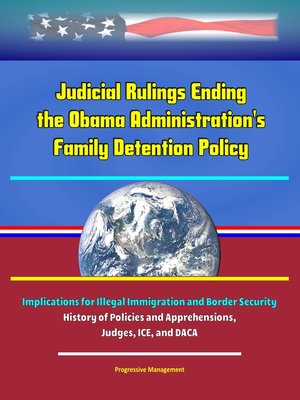Judicial Rulings Ending the Obama Administration's Family Detention Policy
ebook ∣ Implications for Illegal Immigration and Border Security--History of Policies and Apprehensions, Judges, ICE, and DACA

Sign up to save your library
With an OverDrive account, you can save your favorite libraries for at-a-glance information about availability. Find out more about OverDrive accounts.
Find this title in Libby, the library reading app by OverDrive.



Search for a digital library with this title
Title found at these libraries:
| Library Name | Distance |
|---|---|
| Loading... |
This Congressional report has been professionally converted for accurate flowing-text e-book format reproduction. The political debate over immigration—both legal and illegal—has become steadily more divisive over the last few decades, resulting in a policy stalemate. The complexity, inadequacy of information, and changing nature of the problem only deepen the challenge of finding solutions. No one really knows how many people enter the United States illegally each year, or how many people currently reside in the country illegally. The number of apprehensions is often used as a surrogate statistic to estimate the levels of illegal immigration and residency. It is an imperfect surrogate to say the least. To illustrate one distortion, some Mexican migrants living close to the border who attempt to enter the country illegally may be apprehended multiple times. Migrants from Central America who are apprehended and returned to their countries of origin do not have the same opportunity for multiple illegal crossings. As a result, multiple apprehensions of Mexicans tend to overstate the assumed extent of illegal immigration. Even the definition of "apprehension" itself has changed over time, further distorting the numbers.
When the 1986 Immigration Reform and Control Act was passed, it was estimated that 1.5 million people would avail themselves of the amnesty. Instead, 2.7 million people were granted amnesty. Since 1986, the estimated number of individuals in our country illegally has steadily increased. Using one modeling method, the generally accepted number is currently around 12 million. However, two Yale University researchers recently used a different statistical modeling method and estimated a range between 16 and 30 million people in the United States illegally. No one really knows the true number of illegal immigrants in the U.S.: further evidence that this problem is out of control. Better barriers, erected in the appropriate border areas, are a necessary first step in solving this growing problem. But changes in law are just as crucial to eliminate the incentives and rewards that fuel an increasing number of unaccompanied alien children and family units to enter the United States illegally. Obvious changes required to actually fix the problem include: differentiating the hurdle to establish credible fear for legal versus illegal entry; replacing the courts' reinterpretation of the Flores settlement agreement with standards that allow for an adequate detention period; repealing the law that treats unaccompanied alien minors differently based on where they come from; and placing limits on the number of appeals allowed for denied asylum claims. Any immigration reform proposal that does not include these elements will simply add to the long list of failed legislation that has come before.
This compilation includes a reproduction of the 2019 Worldwide Threat Assessment of the U.S. Intelligence Community.







